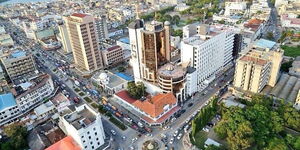A resurgence of the United States Dollar and the high demand for foreign currency by the importers has plunged the Kenyan shilling into four days of consecutive drop in value.
As of Thursday, May 23, commercial banks quoted the shilling at 132.00/133.00 to the US currency compared with Monday’s closing rate of 131.50/132.50.
Even so, the Central Bank of Kenya has moved in to save the Kenya Shilling from weakening further against the US Dollar which is now in high demand.
Commercial banks have in recent weeks bought more US dollars from the Central Bank to sell to manufacturers who need to import supplies.
A report by Reuters disclosed that the Central Bank provided support for the Shilling by selling the US Dollars in small amounts to ensure stability.
Despite the quick intervention, experts warned that the intervention would not last as there was still pressure on the foreign exchange rates.
"As we head towards the end of the month we're seeing a bit of pressure build-up, but we've seen the central bank provide some support," said a foreign exchange trader.
"There's generally more foreign exchange demand than supply but no panic-buying."
The shilling has been weakening against the dollar due to high demand for the US currency by commercial banks and importers including oil importers and manufacturers.
Fuel retailers and manufacturers conducting business on the international front have in recent weeks been hit by a Dollar shortage. A dollar shortage means that those demanding the dollar have to bid for it at higher prices thus affecting the foreign exchange rates.
The latest resurgence of the Dollar against major world currencies has also been attributed to the weakening of the local currency.
A stronger dollar has been attributed to the ongoing geopolitical wrangles that have raised investors' jitters as dollar inflows reduced.
The weakening of the shilling comes barely a fortnight after experts predicted that the local currency was bound to weaken against a scarce dollar.
Kenya's shilling has been stable but it could weaken in coming days due to demand from fuel retailing companies,” noted the analysts.
There are growing fears that a further weakening of the shilling could mean a return to costlier debt servicing.
In April this year, the Central Bank governor, Kamau Thugge revealed that the country's debt had been cut by Ksh1 trillion. Initially, the Kenyan debt stood at Ksh11 trillion.
The debt reduction was attributed to the gains made by the local currency which was ranked as the world's best-performing currency against the US dollar.
A report by the World Bank in April ranked the Kenyan shilling as the best currency in Sub-Saharan Africa after recording a 20 per cent improvement in performance.
"The Kenyan Shilling is the best-performing currency in the subcontinent as it recorded an appreciation of 16 per cent so far this year," the World Bank noted in its report.
The strengthening of the Kenya shilling was attributed to increased dollar inflow from tea and coffee exports and a hike in diaspora remittances.
A buyback of the Ksh310 billion ($2 billion) 2014 Eurobond was also a major contributor to the stability of the Kenyan currency.












